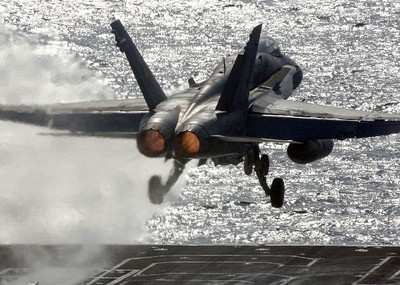Mon, Nov 19, 2012
Both Aircraft Are Now Equipped To Participate In Live, Virtual And Constructive Training Simulations
Two military aircraft produced by Boeing ... the F-15E Eagle and the F/A-18E Super Hornet ... now are equipped to train in an environment that puts them at odds against real aircraft and computer-generated enemy threats at the same time. Under a $6.3 million, three-year contract with the U.S. Air Force Research Laboratory, Boeing is developing these simulation capabilities for both the U.S. Air Force F-15E and the U.S. Navy F/A-18E/F. Under the current contract, the pilot project will culminate with a capstone demonstration at Nellis Air Force Base in Nevada in late 2013.

This technology can provide aircrews with a complex virtual strike environment in which to train, while potentially decreasing the number of real aircraft and other assets to practice against. Generally, an actual combat aircraft (live) is networked with ground-based simulation computers (virtual) that provide computer-generated threats (constructive). Before this new capability, pilots could practice using flight simulators on the ground, but when they trained in the actual aircraft, other people were needed to play the role of an opponent, commonly referred to as a "red" or adversary team.
Having a virtual combat simulation while actually flying is expected to reduce the number of real aircraft or other live assets needed to form a red team, providing cost-savings and a safer training environment. Anticipating the future needs of both the U.S. Navy and U.S. Air Force, Boeing began developing this modeling and simulation technology on its own in 2007, which reduced the government's risk in exploring the capability. A series of demonstrations with an F-15E through November 2009 verified key components. And a Super Hornet recently completed its first flight tests to evaluate these new technologies. "It's exciting to see the technology grow and mature across multiple platforms while supporting the U.S. Navy's vision," said Rob Lechner, pilot project manager and a chief engineer in Boeing Research & Technology.

During the most recent flight tests, two F/A-18Es and two F-15Es simulated air combat between two live F-16s and 12 virtual aircraft, as well as multiple ground threats. A 40/45 Airborne Early Warning and Control System (AWACS) surrogate provided command and control for the exercise. "The integrated training environment can generate warfighter readiness and make aviation flight training much more effective," said John Schwering, Boeing business development leader for integrated Live, Virtual and Constructive training. "Training can be significantly enhanced by increasing the overall threat density with the use of more sophisticated constructive adversary aircraft and ground-based electronic warfare threats."
(Pictured Top: F-15E Eagle, Bottom: F/A-18 Super Hornet)
More News
From 2023 (YouTube Edition): An Even Faster Rolling Extra! Jim Campbell joined General Manager of Extra Aircraft Duncan Koerbel at AirVenture 2023 to talk about what’s up and>[...]
“Receiving our Permit to Fly and starting Phase 4 marks a defining moment for Vertical Aerospace. Our team has spent months verifying every core system under close regulatory>[...]
Middle Marker A marker beacon that defines a point along the glideslope of an ILS normally located at or near the point of decision height (ILS Category I). It is keyed to transmit>[...]
The Experienced Pilot Chose To Operate In Instrument Meteorological Conditions Without An Instrument Flight Rules Clearance Analysis: The airplane was operated on a personal cross->[...]
Also: ATI Strike Prep, Spirit Still Troubled, New CubCrafters Dealership, A-29 Super Tucano Samaritan’s Purse is officially moving its historic Douglas DC-8 cargo jet into re>[...]
 Classic Aero-TV: Extra Aircraft Announces the Extra 330SX
Classic Aero-TV: Extra Aircraft Announces the Extra 330SX Aero-News: Quote of the Day (11.15.25)
Aero-News: Quote of the Day (11.15.25) ANN's Daily Aero-Term (11.15.25): Middle Marker
ANN's Daily Aero-Term (11.15.25): Middle Marker NTSB Final Report: Lancair 320
NTSB Final Report: Lancair 320 Airborne 11.14.25: Last DC-8 Retires, Boeing Recovery, Teeny Trig TXP
Airborne 11.14.25: Last DC-8 Retires, Boeing Recovery, Teeny Trig TXP




